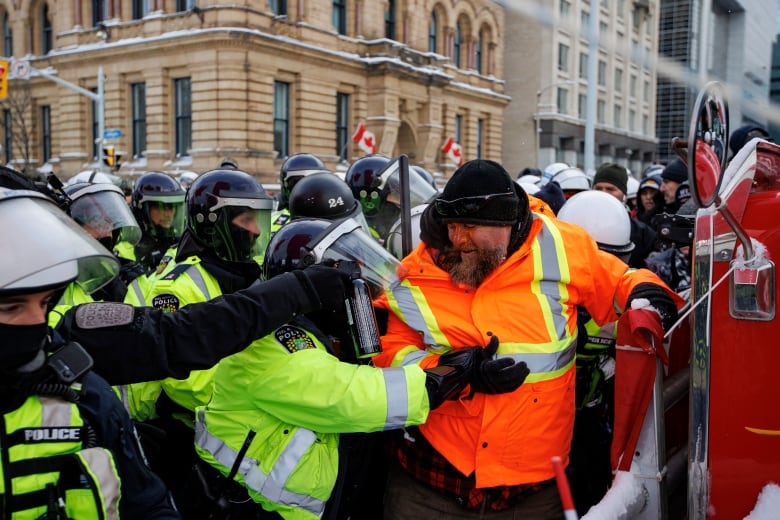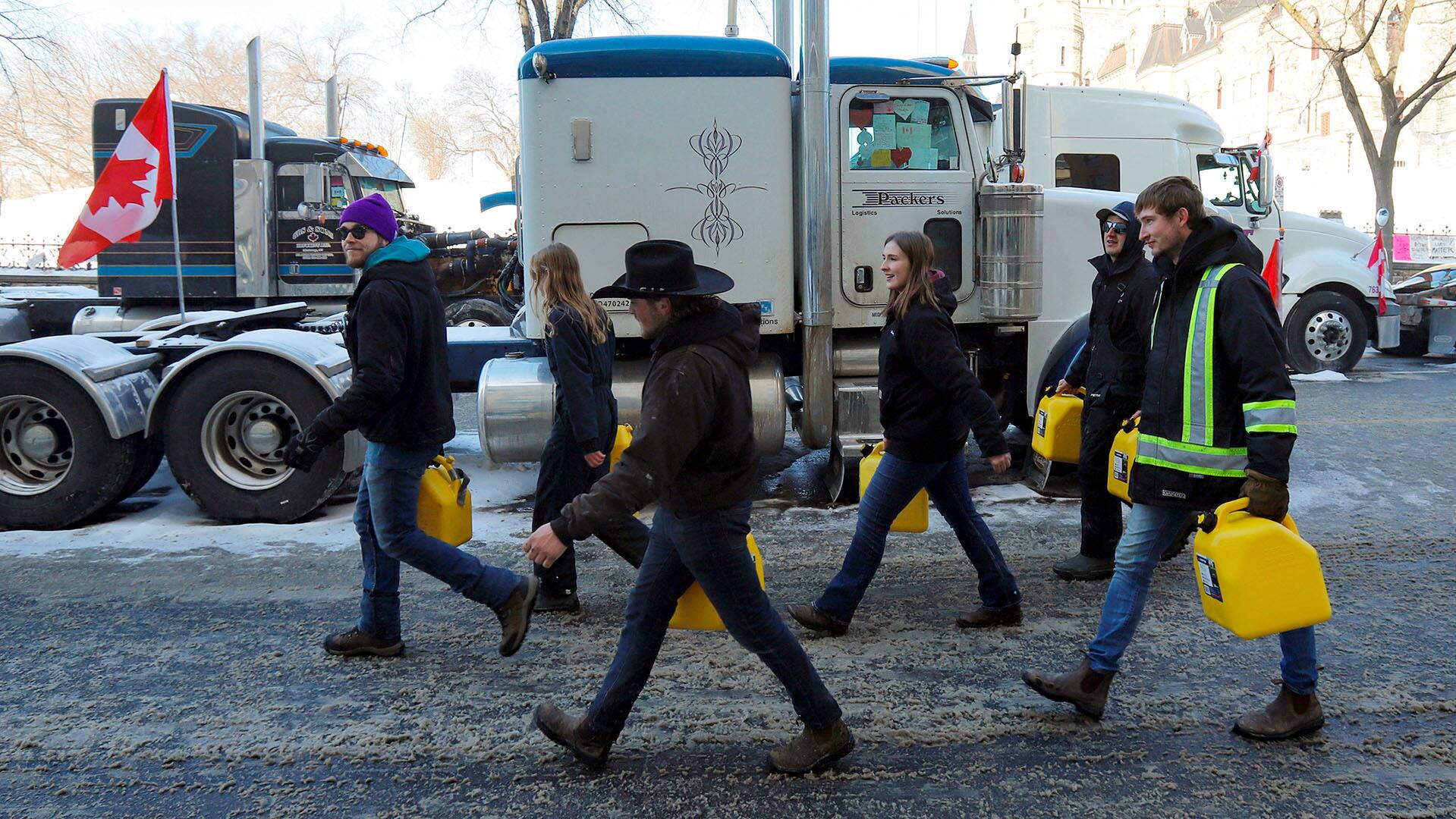RCMP feared that Mounties might leak operational plans to convoy protesters: documents | CBC News
The RCMP feared that serving Mounties sympathetic to the convoy protest against pandemic measures in Ottawa earlier this year might leak operational plans to protesters, says an internal threat advisory obtained by CBC News.
“The potential exists for serious insider threats,” says the Feb. 10 advisory from the RCMP’s ideologically motivated criminal intelligence team.
“Those who have not lost their jobs but are sympathetic to the movement and their former colleagues may be in a position to share law enforcement or military information to the convoy protests.”
The document, obtained by CBC News through an access to information request, shows the RCMP worried that some of their own might co-operate with the protesters who barricaded streets in downtown Ottawa for weeks.
It was well-documented during the protests that some key convoy supporters had previous ties to law enforcement — among them a former RCMP officer who was on the prime minister’s security detail and a former military intelligence officer.
That sparked concerns within the RCMP’s ideologically motivated criminal intelligence unit about convoy participants getting an inside track on how police operate.
“Convoy supporters formerly employed in law enforcement and the military have appeared alongside organizers and may be providing them with logistical and security advice, which may pose operational challenges for law enforcement should policing techniques and tactics be revealed to convoy participants,” says the unit’s advisory.
Barbara Perry, director of the Centre on Hate, Bias and Extremism, said it’s no surprise the RCMP was worried about members leaking information to convoy participants.
“We have to look at what we do know about sexism, misogyny and racism within the RCMP. And you know, those are the bread and butter of the far-right movement,” she said.
Perry said researchers have been able to delve into extremism in the Canadian Armed Forces, but researching extremist ties in law enforcement has been harder.
“That thin blue line is alive and well and police are very reticent to speak about these sorts of issues,” she said.

“We haven’t really done a whole lot of research in the Canadian context but in the U.S., study after study shows that law enforcement rates very high in terms of authoritarian values, which is part and parcel of the far-right as well. So I think there’s definitely overlap.”
CBC asked the RCMP whether its concerns about “insider threats” ever materialized. The police force did not respond in time for publication.
Michael Kempa, an associate professor of criminology at the University of Ottawa, said worries about information leaks may have played a role in how police shared information during the convoy occupation.
“When the convoy had settled in, there would have been concerns in all police organizations that there would be a small number of police with sympathies for the convoy,” he said.
“That’s because there’s these sympathies in our society. So yes, I would be very confident that police leadership would have been careful in how they were sharing information, taking that into consideration.”
Security adviser ‘unclear’ on OPS enforcement plan
The police response to last winter’s Freedom Convoy protests will take centre stage next month when a public inquiry begins its study of the federal government’s rationale for using emergency measures.
Concerns about how information was being shared among police and security forces was teased out in talking points prepared for Prime Minister Justin Trudeau’s national security and intelligence adviser — also released to CBC News in the same access-to-information package.
On Feb. 9, according to the documents, national security adviser to the prime minister Jody Thomas held a meeting with federal deputy ministers to update them on the protests and the police response.

By that date, a dedicated cohort of protesters upset with COVID-19 public health measures had blocked city streets for nearly 13 days, prompting the City of Ottawa to declare a state of emergency. Mayor Jim Watson described the situation as the “the most serious emergency our city has ever faced.”
Peter Sloly, chief of the Ottawa Police Service (OPS) at the time, told a Feb. 7 Ottawa city council meeting that he needed an influx of almost 2,000 police officers and civilians to “turn up the heat.”
But Sloly’s plans for going forward weren’t clear to everyone involved.
“Over the course of the two weekends and throughout the weeks, OPS has brought in additional police resources from a number of Ontario municipalities and the OPP, depending upon the estimated and actual number of protesters,” Thomas’s notes say.
“However, the OPS has not yet shared its forward plan for enforcement with partners and it is unclear whether the plan has been developed. This has resulted in some surge resources from OPP and other municipal law enforcement being redeployed.”
A spokesperson for the Privy Council Office (PCO) said the term “partners” would have referred to other security and policing agencies, including the RCMP and the Parliamentary Protective Services.
When asked for more details about the enforcement plan, a spokesperson for the Ottawa Police Service said the force will not comment “while the parliamentary review is underway.”
The RCMP also wouldn’t comment on the discussions the Mounties were having at the time with the OPS, the main police force of jurisdiction for the Ottawa protest.
“It would not be appropriate to comment on specific operational discussions that took place with our law enforcement and security partners at the time, as this information will be disclosed in due course at the Public Order Emergency Commission,” said RCMP spokesperson Charlotte Hibbard.
“The RCMP has a longstanding positive relationship with the Ottawa Police Service and other law enforcement and security partners within the National Capital Region. “

Scott Blandford is an assistant professor and program coordinator for the policing and master of public safety program at Wilfrid Laurier University in Waterloo, Ont. He said that when one police force sends aid to another, they usually keep each other in the loop.
“I personally can’t see an organization withholding intelligence and information once another organization has committed to provide aid,” he said.
“I think what happened here was that the situation was so dynamic, was changing by the day, not only by the number of people that were becoming involved and what their involvement was. And in a lot of ways … the initial movement was co-opted by a number of other organizations which kept adding new layers and new dimensions to it.”
In such a fast-changing climate, he said, policing plans might have to change daily.
U.S. nudged Canada to use emergency powers: docs
The documents released to CBC also show the government crafted a strategic action plan sometime between Jan. 24 and Feb. 11 that raised concerns about how police were responding to the protests.
According to the plan document, the purpose of the plan was to “support a discussion by committee members on the strategic direction and ideas for federal actions to empower the City of Ottawa’s resolution of the ongoing demonstration.” (PCO did not identify the committee in question for CBC News.)
“There is currently no clear path and an escalation of sympathetic protests across Canada risks further jeopardizing the national interest,” says the document.
“The ineffectiveness of governments and law enforcement to resolve this situation is drawing the attention of the public from the occupiers’ actions to the lack of response.”
On Feb. 12, the OPS, the Ontario Provincial Police and the RCMP formed an Integrated Command Centre to coordinate their response to the Ottawa protests.
By that point, other protests against pandemic measures were erupting across the country. One shut down the border crossing at the Ambassador Bridge in Windsor. Ont. — Canada’s busiest commercial route.
On Feb. 10, the U.S. urged the federal government to use its emergency powers to end border blockades, according to a Privy Council Office national operations update released as part of the document dump.
On Feb. 14, Trudeau announced the government would invoke the Emergencies Act for the first time since it was crafted in 1988 — a controversial move that gave authorities temporary powers that included the ability to freeze the bank accounts and credit cards of protesters. Attending any event deemed an unlawful assembly, such as the Ottawa convoy protest, also became illegal.
“It is now clear that there are serious challenges to law enforcement’s ability to effectively enforce the law,” Trudeau said during a news conference that day. The act was revoked on Feb. 23 after police cleared Ottawa streets.
Talk of a ‘breakthrough’ the night before invocation
According to court documents previously made public, Thomas — who was the former deputy minister of national defence before becoming Trudeau’s top intelligence adviser — told cabinet there was “potential for a breakthrough” with convoy leaders the night before the Emergencies Act was invoked.
Those redacted court documents were filed recently in Federal Court as part of a lawsuit challenging the government’s use of the act.
The court documents do not include any details about the possible breakthrough cited by Thomas on Feb. 13.
The office of Canada’s public safety minister has since said that Thomas was referring to negotiations led “principally” by the City of Ottawa that were “ultimately unsuccessful” after being “disavowed” by many associated with the convoy.
“The government considered this as a factor in the decision to invoke the Emergencies Act,” said a statement from Public Safety Minister Marco Mendicino’s office.
“The situation remained volatile and the threat of future blockades remained. In Ottawa, there was a significant escalation in the boldness of the protestors and … the city’s 911 system was overloaded due to hoax calls.”
WATCH | Why Ottawa protesters seem to be a step ahead of police
Experts say the presence of former police officers within the ranks of the Ottawa protesters is giving them a tactical edge over local law enforcement.
Weeks after the occupation ended, Thomas defended the decision to use the act, saying the protesters were “dug in” and “there’s no doubt [they] came to overthrow the government.”
The government’s decision to invoke the Emergencies Act has drawn intense criticism from political opponents and civil liberty advocates.
From the opposition benches, Mendicino has faced calls to resign and questions about who wanted the government to deploy emergency powers.
As part of the Emergencies Act, a public inquiry is being held to analyze the federal government’s reasons for deploying emergency measures.
That inquiry was scheduled to start later this month but has been delayed until Oct. 13.
Share this news on your Fb,Twitter and Whatsapp
Times News Network:Latest News Headlines
Times News Network||Health||New York||USA News||Technology||World News
